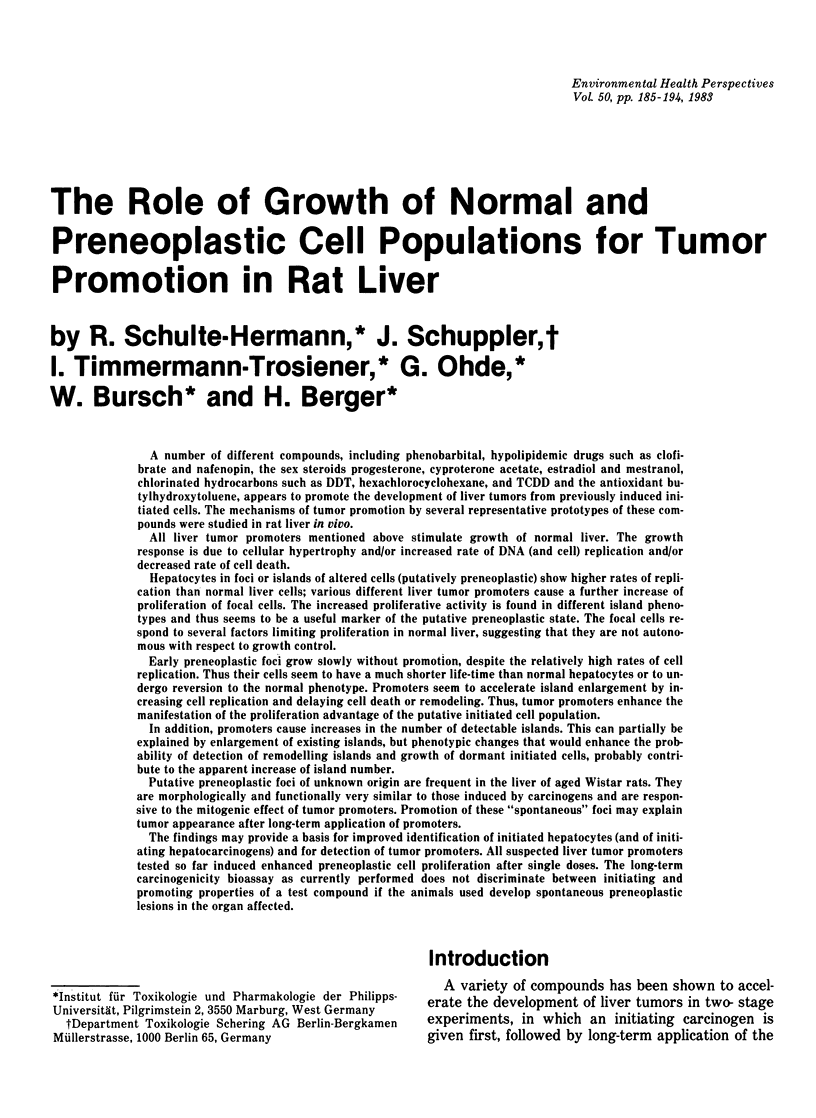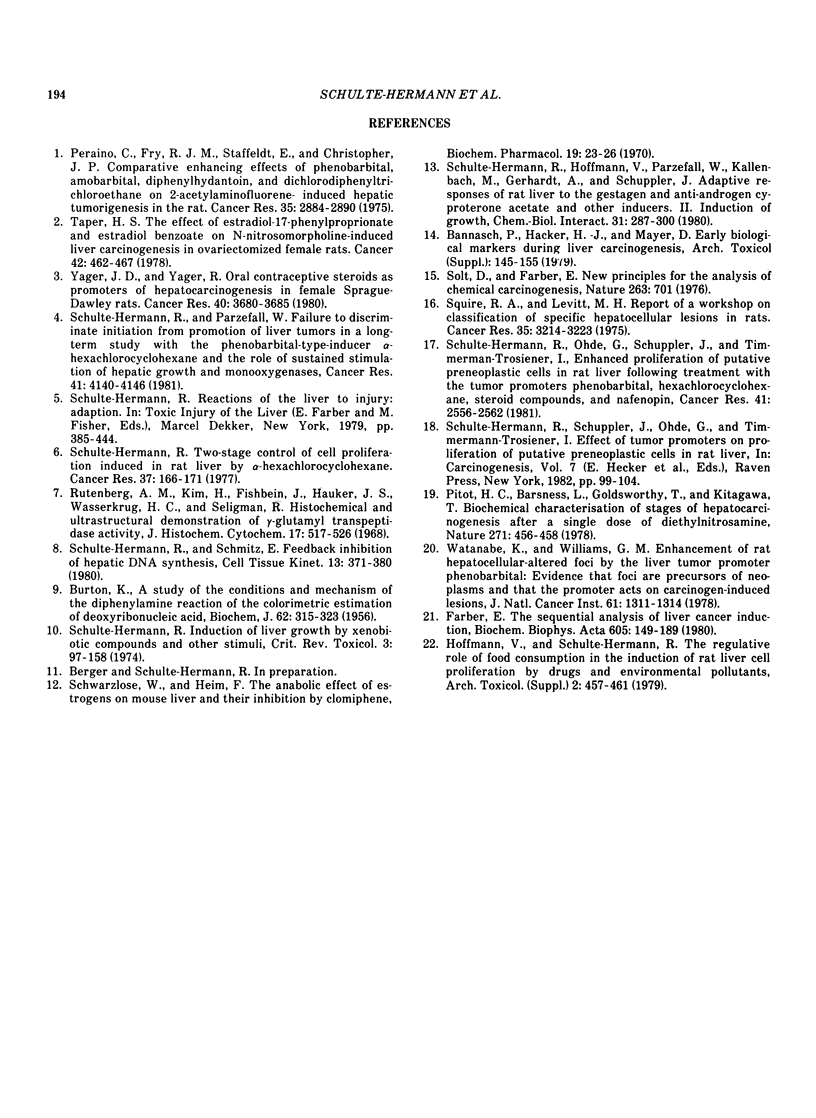Abstract
A number of different compounds, including phenobarbital, hypolipidemic drugs such as clofibrate and nafenopin, the sex steroids progesterone, cyproterone acetate, estradiol and mestranol, chlorinated hydrocarbons such as DDT, hexachlorocyclohexane, and TCDD and the antioxidant butylhydroxytoluene, appears to promote the development of liver tumors from previously induced initiated cells. The mechanisms of tumor promotion by several representative prototypes of these compounds were studied in rat liver in vivo.
All liver tumor promoters mentioned above stimulate growth of normal liver. The growth response is due to cellular hypertrophy and/or increased rate of DNA (and cell) replication and/or decreased rate of cell death.
Hepatocytes in foci or islands of altered cells (putatively preneoplastic) show higher rates of replication than normal liver cells; various different liver tumor promoters cause a further increase of proliferation of focal cells. The increased proliferative activity is found in different island phenotypes and thus seems to be a useful marker of the putative preneoplastic state. The focal cells respond to several factors limiting proliferation in normal liver, suggesting that they are not autonomous with respect to growth control.
Early preneoplastic foci grow slowly without promotion, despite the relatively high rates of cell replication. Thus their cells seem to have a much shorter life-time than normal hepatocytes or to undergo reversion to the normal phenotype. Promoters seem to accelerate island enlargement by increasing cell replication and delaying cell death or remodeling. Thus, tumor promoters enhance the manifestation of the proliferation advantage of the putative initiated cell population.
In addition, promoters cause increases in the number of detectable islands. This can partially be explained by enlargement of existing islands, but phenotypic changes that would enhance the probability of detection of remodelling islands and growth of dormant initiated cells, probably contribute to the apparent increase of island number.
Putative preneoplastic foci of unknown origin are frequent in the liver of aged Wistar rats. They are morphologically and functionally very similar to those induced by carcinogens and are responsive to the mitogenic effect of tumor promoters. Promotion of these “spontaneous” foci may explain tumor appearance after long-term application of promoters.
The findings may provide a basis for improved identification of initiated hepatocytes (and of initiating hepatocarcinogens) and for detection of tumor promoters. All suspected liver tumor promoters tested so far induced enhanced preneoplastic cell proliferation after single doses. The long-term carcinogenicity bioassay as currently performed does not discriminate between initiating and promoting properties of a test compound if the animals used develop spontaneous preneoplastic lesions in the organ affected.
Full text
PDF









Images in this article
Selected References
These references are in PubMed. This may not be the complete list of references from this article.
- BURTON K. A study of the conditions and mechanism of the diphenylamine reaction for the colorimetric estimation of deoxyribonucleic acid. Biochem J. 1956 Feb;62(2):315–323. doi: 10.1042/bj0620315. [DOI] [PMC free article] [PubMed] [Google Scholar]
- Farber E. The sequential analysis of liver cancer induction. Biochim Biophys Acta. 1980 May 6;605(2):149–166. doi: 10.1016/0304-419x(80)90002-5. [DOI] [PubMed] [Google Scholar]
- Peraino C., Fry R. J., Staffeldt E., Christopher J. P. Comparative enhancing effects of phenobarbital, amobarbital, diphenylhydantoin, and dichlorodiphenyltrichloroethane on 2-acetylaminofluorene-induced hepatic tumorigenesis in the rat. Cancer Res. 1975 Oct;35(10):2884–2890. [PubMed] [Google Scholar]
- Pitot H. C., Barsness L., Goldsworthy T., Kitagawa T. Biochemical characterisation of stages of hepatocarcinogenesis after a single dose of diethylnitrosamine. Nature. 1978 Feb 2;271(5644):456–458. doi: 10.1038/271456a0. [DOI] [PubMed] [Google Scholar]
- Schulte-Hermann R., Hoffman V., Parzefall W., Kallenbach M., Gerhardt A., Schuppler J. Adaptive responses of rat liver to the gestagen and anti-androgen cyproterone acetate and other inducers. II. Induction of growth. Chem Biol Interact. 1980 Sep;31(3):287–300. doi: 10.1016/0009-2797(80)90017-4. [DOI] [PubMed] [Google Scholar]
- Schulte-Hermann R. Induction of liver growth by xenobiotic compounds and other stimuli. CRC Crit Rev Toxicol. 1974 Sep;3(1):97–158. doi: 10.3109/10408447409079856. [DOI] [PubMed] [Google Scholar]
- Schulte-Hermann R., Ohde G., Schuppler J., Timmermann-Trosiener I. Enhanced proliferation of putative preneoplastic cells in rat liver following treatment with the tumor promoters phenobarbital, hexachlorocyclohexane, steroid compounds, and nafenopin. Cancer Res. 1981 Jun;41(6):2556–2562. [PubMed] [Google Scholar]
- Schulte-Hermann R., Parzefall W. Failure to discriminate initiation from promotion of liver tumors in a long-term study with the phenobarbital-type inducer alpha-hexachlorocyclohexane and the role of sustained stimulation of hepatic growth and monooxygenases. Cancer Res. 1981 Oct;41(10):4140–4146. [PubMed] [Google Scholar]
- Schulte-Hermann R., Schmitz E. Feedback inhibition of hepatic DNA synthesis. Cell Tissue Kinet. 1980 Jul;13(4):371–380. doi: 10.1111/j.1365-2184.1980.tb00476.x. [DOI] [PubMed] [Google Scholar]
- Schulte-Hermann R. Two-stage control of cell proliferation induced in rat liver by alpha-hexachlorocyclohexane. Cancer Res. 1977 Jan;37(1):166–171. [PubMed] [Google Scholar]
- Schwarzlose W., Heim F. The anabolic effects of estrogens on mouse-liver and their inhibition by clomiphene. Biochem Pharmacol. 1970 Jan;19(1):23–26. doi: 10.1016/0006-2952(70)90325-4. [DOI] [PubMed] [Google Scholar]
- Squire R. A., Levitt M. H. Report of a workshop on classification of specific hepatocellular lesions in rats. Cancer Res. 1975 Nov;35(11 Pt 1):3214–3223. [PubMed] [Google Scholar]
- Taper H. S. The effect of estradiol-17-phenylpropionate and estradiol benzoate on N-nitrosomorpholine-induced liver carcinogenesis in ovariectomized female rats. Cancer. 1978 Aug;42(2):462–467. doi: 10.1002/1097-0142(197808)42:2<462::aid-cncr2820420213>3.0.co;2-s. [DOI] [PubMed] [Google Scholar]
- Watanabe K., Williams G. M. Enhancement of rat hepatocellular-altered foci by the liver tumor promoter phenobarbital: evidence that foci are precursors of neoplasms and that the promoter acts on carcinogen-induced lesions. J Natl Cancer Inst. 1978 Nov;61(5):1311–1314. [PubMed] [Google Scholar]
- Yager J. D., Jr, Yager R. Oral contraceptive steroids as promoters of hepatocarcinogenesis in female Sprague-Dawley rats. Cancer Res. 1980 Oct;40(10):3680–3685. [PubMed] [Google Scholar]




